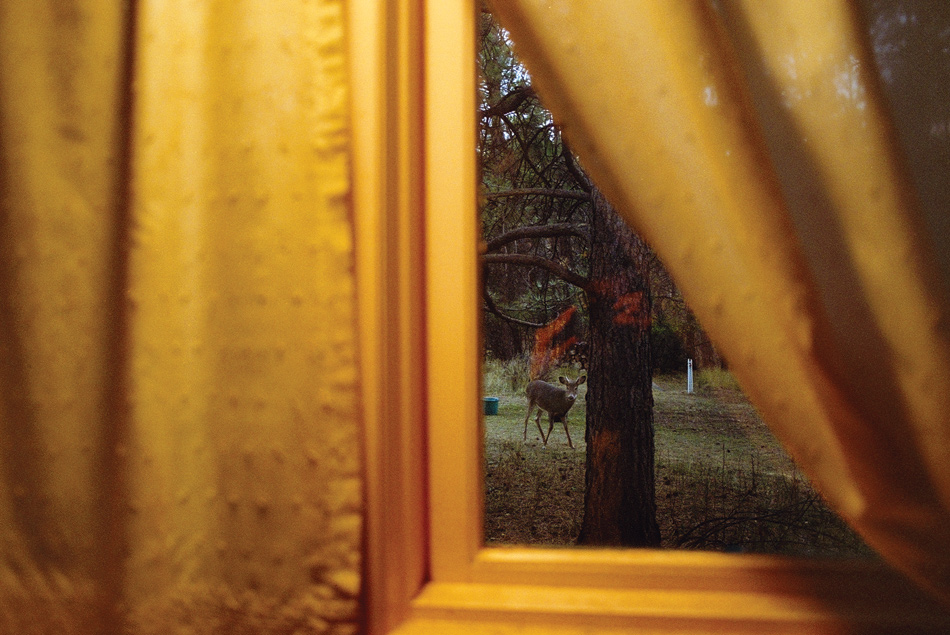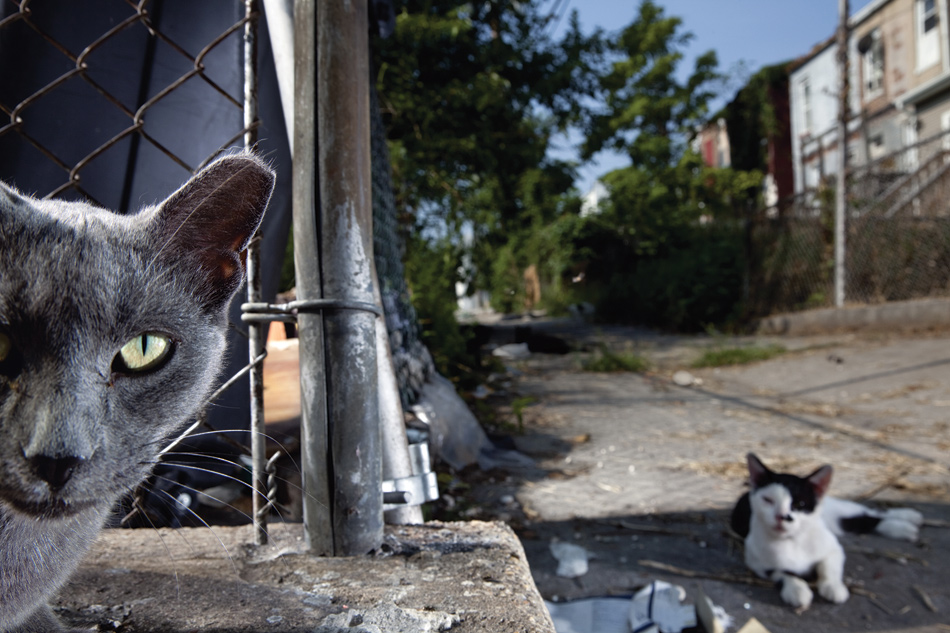Glancing out the kitchen window one sunny afternoon not long ago, I was startled to see two beautiful red foxes copulating in the garden. It was not the unabashed sexual display that was remarkable. Mating must be routine exercise out there, judging by the frequency with which brand-new rabbits can be seen eating the lawn, but foxes are another matter. This is an in-town garden at a well-trafficked intersection two blocks from the county courthouse, definitely not a fox-friendly location. A single fox doing nothing at all on this turf would be a newsworthy sight; two foxes engaged in propagating the species would seem to border on the unthinkable.
Jim Sterba, on the other hand, believes it entirely thinkable. His Nature Wars: The Incredible Story of How Wildlife Comebacks Turned Backyards into Battlegrounds argues persuasively that events like this foxes-in-the-garden sighting are evidence that humans are losing some kind of property rights struggle with creatures of the wild. He cites an extensive history of resolute and sometimes blatantly hostile real-estate invasion by beavers, Canada geese, wild turkeys, and white-tailed deer, all of which were once assumed to be picturesque and even lovable denizens of the dark and safely remote forest. In-town appearances by coyotes and bears are now commonplace in communities across the country, and trespassers in my own garden, aside from the foxes, have included groundhogs, possums, skunks, feral cats, and one blue heron that ate all the koi with which we thought to beautify the fish pond.
Just today, as this is written, the local newspaper has arrived with a front-page headline declaring, “Vultures Take Over Leesburg Neighborhood.” Some 250 of these valuable but socially insufferable birds, it states, have “taken over” a residential area—“stripping bark off trees, eating rubber off roofs, cars, hot tub, pool, and boat covers and destroying grills.”
In the past fifty years or less, all these woodland creatures seem to have discovered that life among the humans can be just as comfortable as it is in the forest, and the eating perhaps even easier. The woods have no garbage cans and dumpsters filled with discarded food, no lovingly tended tomato plants, no ready-to-pluck dahlias and nasturtiums, no tasty, newly planted shrubs.
Best of all from the animal viewpoint, humans are no longer the same dangerous predators who once pushed the beaver close to extinction and reduced the entire North American white-tailed deer population to a trifling 500,000 scarcely a century ago. Sterba believes that this human withdrawal from combative relations with woodland animals is one of the major causes of their proliferation: man as killer has undergone a softening change.
This kinder, softer American, Sterba notes, has only a remote relationship with the natural world he inhabits. Over a span of some four hundred years Americans necessarily cultivated a close grasp of nature’s laws and whims in order to survive the cruelty of a primordial wilderness, and to level forests, make land productive, and become competent at hunting, fishing, trapping, and animal husbandry.
Now, in little more than a single generation, this long relationship with nature has withered in a culture that finds Americans giving themselves up to the indoor ease of the technological way of life. Today’s average American spends most of the day indoors or inside an automobile traveling some hellish commuter road between workplace and home. Experience of his own natural habitat comes largely from watching beautifully photographed films on television. In Sterba’s word, he has become “denatured.”
Denaturing has produced an unrealistic and somewhat sentimental view of woodland creatures, which, as Sterba construes the situation, is one reason so many seem to feel they can trespass in our gardens with impunity.
His book, written with considerable charm and more wit than commonly found in works that deal with ecosystems, includes extensive and often entertaining treatments of such common nuisances as beavers, Canada geese, and feral cats, as well as various animal support lobbies that make life miserable and sometimes dangerous for wildlife control agents. For the denatured reader, there is a wealth of useful statistics.
Is it generally known, for example, that the beaver is the largest rodent in North America, that the adult male may be four feet long from nose to tail tip and weigh as much as sixty pounds? Or that the giant variety of Canada goose, weighing ten to twenty pounds, does not migrate but likes to settle in groups of hundreds, sometimes thousands, on golf courses and public parklands where, with their distinctively hyperactive digestive systems, they must void their bowels approximately fives times an hour? Or that the population of feral cats is thought to be somewhere between 60 and 100 million, that they have human supporters—even “national cat protection groups”—that wage bitter struggles against songbird lovers who see the wild felines as a threat to the future of beauty on the wing?
Advertisement
Sterba refers to human champions of this animal or that as “species partisans.” Though sympathetic to their devotion to animals and their care for the environment, he clearly disapproves of some of the tactics they employ in pursuit of their high-minded objectives. Officials of an upstate New York village planning to rid the community of an infestation of Canada geese find themselves, for example, confronted by TV crews summoned to cover a protest against a pending “goose Holocaust.” After sharpshooters are hired by Princeton, New Jersey, to cull its deer population, “the mayor’s car was splattered with deer guts and the township animal control officer began wearing a bulletproof vest after finding his dog poisoned and his cat crushed to death.” People “denatured” from their own habitat tended to treat the environment and its other inhabitants in mindless ways, unintentionally and often with the best of intentions.
Early environmentalists, like Thoreau, wrote of a landscape despoiled by ignorance and exploitation, and this narrative of loss through human meddling—the idea of “man the despoiler,” in Sterba’s phrase—still ran strongly through the last century’s environmentalist culture. Sterba writes that this idea led to the notion that the natural world “was a benign place” where wild creatures lived harmoniously among themselves, and only man was vile:
This idea was in striking contrast to the amorality of a Darwinian nature that was indifferent and random, its creatures living in a world of predators and prey, struggling to eat, reproduce, and survive. In a benign natural world, wild animals and birds not only got along with one another but were often portrayed as tame and peaceable, with human habits and feelings.
This, in exaggerated form, was the world of faux nature packaged for delivery to people who wanted to believe that animals were just like us.
Bambi and Lassie are two of the best-known practically human specimens that warm the popular heart. Those who seek something closer to Darwinian reality may prefer Bugs Bunny.
Though tightly focused on the resurgence of wildlife, Sterba’s book is basically about the recent extraordinary changes in the American landscape, the rapidity with which they happened, and how intimately they were interlocked. He defines the major events as the regeneration of the nation’s great eastern forest, the “slaughter and comeback” of its wildlife, and the spread of human population from urban concentration into suburban, exurban, and rural sprawl. His study is confined largely to the vast American deciduous forest land between the Atlantic Ocean and the prairie flatland, where approximately two thirds of Americans now live.
During America’s first 250 years, early settlers cleared away some 250 million acres of forest. Yet the forest comes back fast. By the 1950s, one half to two thirds of the landscape was reforested. Most of us now “live in the woods,” Sterba writes. “We are essentially forest dwellers.” The new forests “grew back right under the noses of several generations of Americans. The regrowth began in such fits and starts that most people didn’t see it happening.”
Why did it happen? For one thing, because oil, gas, and coal replaced wood as the major fuel for heating and cooking. Because new building techniques and materials reduced wood’s importance to the construction trades. And because the family farm began to vanish, leaving the abandoned acreage to follow earth’s natural impulse, which is to produce wild grasses, weeds, bushes, shrubs, and small trees that turn into big trees.
Then, of course, even the bleakest urban areas may yield to a civic impulse to primp a bit with touches of greenery, as in New York where 24 percent of the city’s area is now covered by a canopy of 5.2 million trees. Nationally, Sterba reports, tree canopy covers about 27 percent of the urban landscape.
A lot of this regenerating forest is included in what Sterba calls “sprawl,” a new kind of communal development created by the fateful American decision to let the automobile shape our lives. With the car’s ability to transport a commuter rapidly over considerable distances, human habitations have sprung up in scattered settings, ever more distant from cities—deeper in the woods, as it were. As this motorized workforce flung people outward, the scattering population began to produce new, smaller workplaces—little urboids, too small to be cities, too lifeless to be towns. Bursting forth here and there in the spreading nowhere, they produced “exurban sprawls that have broken free of the gravitational pull of the cities and now float in a new space far beyond them,” as David Brooks has written in The New York Times.
Advertisement
Sterba says that sprawl “can include suburbs, exurbs, golf courses, cropland, pasture, parks, highway median strips, parking lots, McMansions, Burger Kings, and people.” Though not officially defined as forest, sprawl areas, he says, are so covered with trees that they “have the feel of a forest,” and for many wild creatures all the comforts of forest home. In short: ideal territory for a wilderness creature struggling to flourish after a brush with extinction. Hence, foxes in the garden, beaver dams flooding the soccer field, geese emptying their bowels in the old swimming hole, coyotes biting faithful old Rover, and Bambi’s ungulate kin crashing into three thousand automobiles every day.
These creatures that once delighted us by remaining remote and shy of human company have lately changed from remote to chummy, from shy to importunate. For many they have begun to seem just another variety of pest; for some, they are simply menaces. Geese, for instance, have lost many devotees since several were sucked into the engines of a jet departing LaGuardia Airport, in January 2009, and forced an emergency landing on the Hudson River, which 155 people survived only because of the extraordinary skill of pilot and crew.
It is the white-tailed deer, however, that dominate all discussion of wilderness creatures versus human society. This may be because there are simply too many deer for their own good. Sterba’s figures indicate that as recently as 1900 all of North America had a deer population of perhaps 500,000. I recall the excitement of seeing a deer standing perfectly still on a northern California mountainside in 1956. Seeing a deer at all in those years was a thrilling event. Now it is likely to be merely irritating, if not downright alarming.
By the 1990s the deer population had exploded. Various estimates for the United States put it at 25 to 40 million and growing unchecked, and apparently uncheckable. By 2006 this vast and scattered herd was being called “a mass transit system for ticks carrying Lyme disease.” Sterba’s figures put deer damage to farm crops and forests at more than $850 million; the deer had eaten $250 million worth of landscaping, gardens, and shrubbery. By eating plants that grew under large trees they damaged songbird habitats and put certain bird groups at risk.
“But threats to forests and songbirds paled in comparison to the whitetail’s menace to people in the form of collisions of deer and motor vehicles, which were occurring at a rate of three thousand to four thousand per day,” according to Sterba. “The toll of cars crumpled, people killed and injured, Lyme disease contracted, gardens destroyed, crops eaten, and forests damaged,” he writes, justified The New York Times’s editorial conclusion that “white-tailed deer are a plague.”
Sterba lists several factors that made “such beautiful creatures become so much trouble.” These include a lack of predators, a decline in hunting, changes in habitat, mismanagement by state wildlife agencies, and human sprawl.
Whitetails are “quick studies,” he writes. It took them very little time to discover that “people who have sprawled across the landscape aren’t the predators they used to be.” The sprawl people brought with them attitudes that created ideal conditions for a whitetail explosion. Sprawl culture with its “exurban subdivisions, big-box houses on multiacre plots, weekend places, second homes, hobby farms, and even semiworking farms” created “a mosaic of hiding places, open places, feeding places, watering places, bedding places.” Moreover, sprawl people grew many plants they did not eat, harvest, or market. Using “prodigious amounts of fertilizer, water, and hired labor, they grew plants mainly to look at.” They created “deer nirvana,” a wildlife biologist said.
Then, says Sterba, they made one last crucial adjustment: they cleared the landscape of the last major deer predator remaining: themselves. Most did not hunt. They posted their property with “No Hunting” signs and passed laws against discharging firearms that effectively put large areas of landscape off limits for hunting:
Suddenly, for the first time in eleven thousand years, hundreds of thousands of square miles in the heart of the white-tailed deer’s historic range were largely off limits to one of its biggest predators. Suddenly, an animal instinctively wary of predators, including Homo sapiens, found itself in a lush habitat where major predators—drivers being the exception—didn’t exist.
Thinking of possible ways to avert a disaster in deer–human conflicts, Sterba imagines a return of the human predator. He writes of “professional” hunters who are seen as “new saviors” in some suburbs where sharpshooters are hired to kill deer and are paid with tax dollars. He describes a proposal to have professionals train local hunters to become “urban deer managers,” with the costs offset by selling venison in farmers’ markets. “It seems like a good solution,” he concludes, “but it probably won’t happen anytime soon.”
This Issue
February 21, 2013
Speak, Memory
13 Questions for John O. Brennan
Double Agents in Love





